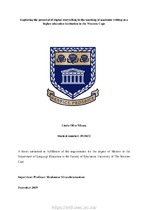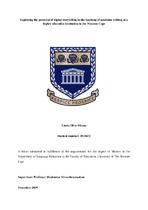| dc.contributor.advisor | Sivasubramaniam, Sivakumar | |
| dc.contributor.author | Mkaza, Linda Olive | |
| dc.date.accessioned | 2021-07-13T10:07:43Z | |
| dc.date.available | 2021-07-13T10:07:43Z | |
| dc.date.issued | 2019 | |
| dc.identifier.uri | http://hdl.handle.net/11394/8278 | |
| dc.description | Magister Educationis - MEd | en_US |
| dc.description.abstract | Writing is an important skill throughout learners’ schooling trajectory because it is through writing that learners need to situate meaning and sense-making across the curriculum. Writing proficiency becomes even more important when learners access tertiary studies. Yet studies suggest that most students struggle with academic writing. Various authors suggest that writing has not been taught appropriately especially in secondary schooling contexts in South Africa and that writing becomes even more daunting for Second Language speakers of English when they reach tertiary education. There is abundant literature on students’ challenges with academic writing and ways to address academic writing challenges but the use of digital storytelling in relation to academic writing development is recent and distinctively underexplored in the literature. In this study, I seek to explore the potential that digital storytelling has in the teaching of undergraduate academic writing skills. I will focus on first year students' academic writing skills, how they are taught currently and how technology in the form of digital storytelling can help first year students improve their academic writing skills. The theoretical framework for the study is largely based on the New Literacies Studies which is championed by members of the New London Group such as Street and Street (1984) Lea and Street (2006) among others. The theoretical framework will draw on the notion of literacy as social practice rather than a set of reading and writing skills which explains why educators need to find new ways of teaching academic writing skills. I use semiotics and multimodality as a foundational concept for using digital storytelling in academic writing. That is because semiotics and multimodality further support the idea that literacy goes beyond words but that audio and visual elements are also part of learning and can help engage students in their academic work. The main aim of this proposed research is to explore both students and lecturer practices of digital literacies in the teaching and learning of academic writing at The Cape Peninsula University of Technology (CPUT). I propose the following research objectives: (i.) elucidate current academic writing scaffolding in academic modules; (ii.) draw on the use of digital storytelling in a first-year undergraduate course; (iii.) shed light on lecturers and students’ perceptions of the ways digital storytelling impacts on first-year academic writing; (iv.) highlight the implications of infusing multimodality into academic writing in this context; and (v.) explore the ways first-year students’ take on new writing practices and how these new practices are facilitated by the ii lecturer. I plan to use a qualitative research method to achieve my set objectives. I have opted to conduct action research, as both participant and researcher. The qualitative research method allows me to use the following research tools: document analysis; questionnaires and interviews. I analyse 15 student essays in order to elucidate current academic writing scaffolding in academic modules. These essays are divided into three categories: high performance; average performance; and low performance. Then questionnaires are distributed to students through a Google Forms link. Of the 40 student participants; 32 students filled in the questionnaires. The interviews were conducted with three lecturers across two departments at CPUT. These interviews, together with questionnaires that the students filled in served to address the following objectives: draw on the use of digital storytelling in a first-year undergraduate course; shed light on lecturers and students’ perceptions of the ways digital storytelling impacts on first-year academic writing; highlight the implications of infusing multimodality into academic writing in this context; and explore the ways first-year students’ take on new writing practices and how these new practices are facilitated by the lecturer. All the ethical considerations were adhered to for my research. I categorized my findings according to the research questions that I posed in the study. There were three research questions which serve as the three main themes of my data analysis. However, during the process of analyzing the data, a fourth theme emerged. The first finding indicates that academic writing scaffolding in academic writing modules is adequate for students who have essays in the high-performance category. However, it is inadequate especially for students who wrote essays in the low performance categories as they could not meet the demands of academic writing. The second finding indicates that students are able to use digital storytelling to help them with various aspects of academic writing. They are able to improve language and grammar; the structure of their writing, that is, the introduction, body and conclusion. The third finding illustrates that lecturers also feel that there are academic writing benefits to when using digital storytelling. Even though that may be, the use of technology for the medium of digital storytelling proved to be somewhat difficult. That is mostly because students did not have access to various technology such as internet connection or even equipment to complete the digital stories unproblematically. Then the fourth finding emerged during lecturer interviews, that is, fees must fall protests and the impact it had on the traditional university structure across. Fees must fall protests led to disruptions in academia because one key aspect they highlight is the need for decolonisation of the curriculum The use of digital storytelling then not only addressed the student academic writing challenges that are highlighted by this study, but also speak to decolonisation of the curriculum because it is an innovative way for students to engage with the demands of academic writing. The conclusion of my thesis is that as useful as digital storytelling is in academic writing; those who wish to use it as a teaching tool need to be well versed with technology as it can have challenges if not used adequately. The most pertinent of the factors revealed is that there is a need for innovative ways to teach the 21st century student. | en_US |
| dc.language.iso | en | en_US |
| dc.publisher | University of the Western Cape | en_US |
| dc.subject | Academic Writing | en_US |
| dc.subject | Academic Literacy | en_US |
| dc.subject | Academic Literacies Model | en_US |
| dc.subject | Academic Socialization Model | en_US |
| dc.subject | Digital Storytelling | en_US |
| dc.subject | English Second Language | en_US |
| dc.subject | Higher Education | en_US |
| dc.subject | Language Multimodality | en_US |
| dc.subject | New Literacies Studies | en_US |
| dc.subject | Semiotics | en_US |
| dc.subject | Social practices | en_US |
| dc.subject | Study Skills Model | en_US |
| dc.title | Exploring the potential of digital storytelling in the teaching of academic writing at a higher education institution in the Western Cape | en_US |
| dc.rights.holder | University of the Western Cape | en_US |




